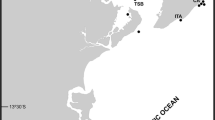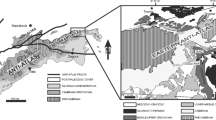Abstract
The massive irruption of the invasive bryozoan Membraniporopsis tubigera (Osburn) in sandy beaches of southern Brazil and Uruguay is reported. The species, originally described from Puerto Rico, Texas and Florida, has also been recorded for Brazilian beaches from 21°S to 26°S as well as for harbours of Australia, New Zealand and the Sea of Japan. The southward spreading rate of this bryozoan along the Brazilian and Uruguayan coasts can be estimated in approximately 183–195 km year−1. The chances that this invasion could proceed southwards in the Southwest Atlantic and the possible impacts that it may be causing are discussed. The case of M. tubigera seems to be qualitatively and quantitatively different from those of other alien bryozoans previously recorded for this region, since it appeared massively in exposed sandy beaches, a habitat regarded to date as apparently free from the pervasive ecological impact of invasion by exotic species in the Southwest Atlantic.



Similar content being viewed by others
References
Allen FE (1953) Distribution of marine invertebrates by ships. Aust J Mar Freshw Res 4:307–316. doi:10.1071/MF9530307
Boschi EE (2000) Species of decapod crustaceans and their distribution in the American marine zoogeographic provinces. Rev Invest Desarr Pesq 13:7–136
Bullivant JS (1968) The rate of feeding of the bryozoan Zoobrotryon verticillatum. N Z J Mar Freshw Res 2:111–134
Buss LW, Jackson JBC (1981) Planktonic food availability and suspension-feeder abundance: evidence of in situ depletion. J Exp Mar Biol Ecol 49:151–161. doi:10.1016/0022-0981(81)90067-8
Calvo G (1984) Ataques de organismos perforantes a 6 especies de maderas expuestas al medio marino. Contr Depart Oceanogr Fac Hum Cienc Montev 1:1–7
Dadón JR (1999) Gestión de sistemas con baja biodiversidad: Las playas arenosas del Noreste de la Provincia de Buenos Aires. In: Matteucci SD, Solbrig OT, Morello J, Haffner G (eds) Biodiversidad y uso de la tierra. Conceptos y ejemplos de Latinoamérica. EUDEBA, Buenos Aires, pp 529–548
Defeo O, Jaramillo E, Lyonnet A (1992) Community structure and intertidal zonation of the macroinfauna on the Atlantic coast of Uruguay. J Coast Res 8:830–839
Escofet A, Gianuca N, Maytía S, Scarabino V (1979) Playas arenosas del Atlántico Sudoccidental entre los 29° y 43° LS.: consideraciones generales y esquema biocenológico. Memorias del Seminario sobre Ecología Bentónica y Sedimentación de la Plataforma Continental del Atlántico Sur. UNESCO, Montevideo, pp 245–258
Garcia VMT, Gianuca NM (1997) The beach and surfzone. In: Seeliger U, Odebrecht C, Castello JP (eds) Subtropical convergence environments. Springer, Berlin, pp 166–170
Gianuca NM (1987) Zonação e produção nas praias arenosas do litoral sul e sudeste do Brasil: síntese dos conhecimentos. Anais do I Simpósio de Ecossistemas da Costa Sul e Sudeste Brasileira. ACIESP, São Paulo, pp 313–332
Gordon DP, Mawatari SF (1992) Atlas of marine-fouling bryozoa of New Zealand ports and harbours. NZOI Misc Publ 107:1–52
Gordon DP, Ramalho LV, Taylor PD (2006) An unreported invasive bryozoan that can afect livelihoods—Membraniporopsis tubigera in New Zealand and Brazil. Bull Mar Sci 78:331–342
Guerrero RA, Piola AR (1997) Masas de agua en la plataforma continental. In: Boschi E (ed) El mar argentino y sus recursos pesqueros 1. Inst Nac Inv Desarr Pesq, Mar del Plata, pp 107–118
Hansen J, Sato M, Ruedy R, Lo K, Lea DW, Medina-Elizalde M (2006) Global temperature change. Proc Natl Acad Sci USA 103:14288–14293. doi:10.1073/pnas.0606291103
Hastings AH (1943) Polyzoa (Bryozoa). I. Scrupocellariidae, Epistomiidae, Farciminariidae, Bicellariellidae, Aeteidae, Scrupariidae. Discov Rep 32:301–510
Kubanin AA (1977a) A new immigrant in the sea of Japan, Conopeum tubigerum (Bryozoa, Cheilostomata). Zool Zh 56:313–315 In Russian, with English summary
Kubanin AA (1977b) Species composition of bryozoans in the foulings of ships with different floating regimes. Biol Morya 6:63–67 In Russian, with English summary
Lichtschein de Bastida V, Bastida R (1980) Los briozoos de las comunidades incrustantes de puertos argentinos. Proceedings of the 5th international congress on marine corrosion and fouling, Mar Biol, Barcelona, pp 371–390
Liu X, Yin X, Xia W (1999) Significance of early astogeny of cheilostome bryozoans in their evolution I. The characteristics of early astogeny of suborder Malacostegina (Membraniporidae and Electridae), with descriptions of a new genus and six new species. Stud Mar Sin 41:128–167 In Chinese, with English summary
Liu X, Yin X, Ma J (2001) Biology of marine-fouling bryozoans in the coastal waters of China. Science Press, Beijing In Chinese, with English summary
Mansur MCD, Heydrich I, Pereira D, Richinitti LMZ, Tarasconi JC, Rios EC (2003) Moluscos. In: Fontana CS, Bencke GA, Reis RE (eds) Livro vermelho da fauna ameaçada de extinção no Rio Grande do Sul. EDIPUCRS, Porto Alegre, pp 49–71
Orensanz JM, Schwindt E, Pastorino G, Bortolus A, Casas G, Darrigran G, Elías R, López Gappa J, Obenat S, Pascual M, Penchaszadeh P, Piriz ML, Scarabino F, Spivak ED, Vallarino EA (2002) No longer the pristine confines of the world ocean: a survey of exotic marine species in the southwestern Atlantic. Biol Inv 4:115–143. doi:10.1023/A:1020596916153
Osburn RC (1940) Bryozoa of Porto Rico with a résumé of the west Indian bryozoan fauna. Sci Surv Porto R Virg Is 16:321–486
Piola AR, Campos EJD, Möller OO Jr, Charo M, Martínez C (2000) Subtropical shelf front off eastern South America. J Geophys Res C 105:6565–6578. doi:10.1029/1999JC000300
Piola AR, Romero SI, Zajaczkovski U (2008) Space-time variability of the Plata plume inferred from ocean color. Cont Shelf Res 28:1556–1567. doi:10.1016/j.csr.2007.02.013
Ryland JS (1965) Catalogue of main marine fouling organisms, vol 2: Polyzoa. Organisation for Economic Co-operation and Development, Paris
Scarabino F (2004) Conservación de la malacofauna uruguaya. Com Soc Malac Urug 8:267–273
Scarabino F (2006) Faunística y taxonomía de invertebrados bentónicos marinos y estuarinos de la costa uruguaya. In: Menafra R, Rodríguez-Gallego L, Scarabino F, Conde D (eds) Bases para la conservación y el manejo de la costa uruguaya. Vida Silvestre Uruguay, Montevideo, pp 113–142
Scarabino F, Zaffaroni JC, Carranza A, Clavijo C, Nin M (2006) Gasterópodos marinos y estuarinos de la costa uruguaya: faunística, distribución, taxonomía y conservación. In: Menafra R, Rodríguez-Gallego L, Scarabino F, Conde D (eds) Bases para la conservación y el manejo de la costa uruguaya. Vida Silvestre Uruguay, Montevideo, pp 143–155
Segura AM, Delgado EA, Carranza A (2008) La pesquería de langostino en Punta del Diablo (Uruguay): un primer acercamiento. Pan Am J Aquat Sci 3:232–236
Vieira LM, Migotto AE, Winston JE (2008) Synopsis and annotated checklist of recent marine bryozoa from Brazil. Zootaxa 1810:1–39
Winston JE (1977) Feeding in marine bryozoans. In: Woollacott RM, Zimmer RL (eds) Biology of bryozoans. Academic Press, New York, pp 233–271
Acknowledgments
The fieldwork was done with the kind collaboration of the crew of the F/V “Dommy”, Karumbé, M. Laporta, A. Estrades, A. Fallabrino, C. Fagúndez, A. Segura, L. Rubio and S. Horta. Financial support from CONICET, The Rufford Small grants for Nature Conservation and British Petroleum to J.L.G., A.C. and Karumbé, respectively, is acknowledged. We also thank S. Sauco for logistic support, C. Romero and P. Laporta for comments on the strandings, C. Fagúndez for the photograph of Fig. 3d and Dennis Gordon for driving our attention to Allen’s paper.
Author information
Authors and Affiliations
Corresponding author
Rights and permissions
About this article
Cite this article
López Gappa, J., Carranza, A., Gianuca, N.M. et al. Membraniporopsis tubigera, an invasive bryozoan in sandy beaches of southern Brazil and Uruguay. Biol Invasions 12, 977–982 (2010). https://doi.org/10.1007/s10530-009-9522-4
Received:
Accepted:
Published:
Issue Date:
DOI: https://doi.org/10.1007/s10530-009-9522-4




